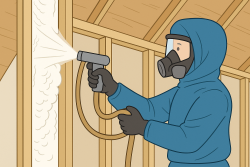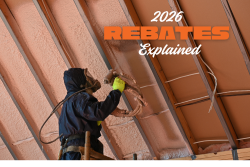The value of spray foam insulation as a superior insulation option in the building and construction section has increased. In the construction industry, it is becoming increasingly popular for many reasons. Building insulation and air sealing can be improved dramatically with spray polyurethane foams (SPF) as roofing, insulation, and sealant product. Due to the widespread use of polyurethane foam in buildings, electrical engineers need to understand how to work with the material.
Architects and builders look for insulation materials that have air-sealing properties. The insulation material forms the air seal, allowing other trades to select and install products more freely. Its connection to neighbouring materials provides more effective protection than other materials. Here are some tips you can follow to minimize problems with electrical work.
Do the Following during the Rough-in Stage
When laying out lines or performing other rough-in-stage tasks, ensure wires are pulled tightly and tacked roughly every 24 inches. This will reduce the chances of displacement due to foam expansion.
As the foam expands, it can move into all open spaces. Therefore, cover the face of all electrical boxes, circuits and equipment to prevent foam from entering unwanted places.
Use air-sealing electrical boxes to prevent foam from migrating into the electrical boxes.
Spray foam is combustible and should be kept away from high-temperature devices and utilities. You can use a plasterboard wall and an airbase for this.
If you are wiring big loads in well-insulated assemblies, follow standard de-rating processes.
Wiring should not be done while SPF is being sprayed. It is best to stay away from the area while spraying SPF and even 24 hours after spray.
Ensure Safety Every Time
Whenever using spray foam, keep foam solvent available near you. Wear eye protection to ensure safety. To avoid potential hazards, turn off the power before insulating your ports or electrical box.
Fill the Spaces
Use spray foam insulation in the spaces around your outlets. With an instant payoff, it is a quick and easy task. Use spray foam to fill the space between the exterior wall and the rear of the electrical panel. The foam should be inserted between the box and the outer wall.
Keep Foam Insulation Away from Box
Be cautious while laying foam close to electrical boxes and cables. Make sure the foam doesn't get inside the electrical panel. It will cause severe problems by solidifying the parts of the entire box. Remember that the components of spray foam are flammable. Pick inexpensive foam that is maintained away from electrical and box components as a precaution. Ensure all overspray foam is removed from the electrical boxes and equipment.
Use industry resources and education to learn about it, as spray foam insulation is becoming increasingly popular in residential and commercial construction. Selecting a professional contractor to install SPF is an important decision for architects and builders. Each manufacturer provides a model specification to assist architects and specifiers in making the right choice.
Also, check out his blog A Beginner's Guide to Basement Insulation.
Hire Reitzel Insulation
Choose Reitzel Insulation for reliable and flawless installation. During the installation and after, we educate architects and builders about the product, its applications, and the installation process, including any mechanical ventilation requirements. Contact us today!

















